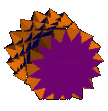





Cupola OR Semicupola
For each n/d (within the bounds of 6/5<n/d<6) one of three conditions applies:
1. n/d are co-prime, d odd: A cupola exists with bases n/d and 2n/d
2. n/d are co-prime, d even: A semicupola exists with bases n/d and 2n/d which is equivalent to 2 x n/(d/2), the latter face being faceted.
3. n/d are not coprime: No elementary cupola or semicupola exists, but compound cupolas or semicupolas may.
So for any n/d there may be a cupola or a semicupola but not both.
Table of cupolas and semicupolas
Cupolas in red, semicupolas in blue.
The list is complete for
cupolas for n<=10 and for semicupolas with n<=12. The
term ssq is used to denote a sesquicupola.
| 2/1
ssq |
|||||||
| 3/1
ssq |
3/2 | ||||||
| 4/1
ssq |
4/3
ssq |
||||||
| 5/1 ssq |
5/2 | 5/3
ssq |
5/4 | ||||
| 7/2 | 7/3
ssq |
7/4 | 7/5
ssq |
||||
| 8/3
ssq |
8/5
ssq |
||||||
| 9/2 | 9/4 | ||||||
| 10/3
ssq |
10/7
ssq |
||||||
| 11/2 | 11/4 | 11/6 | 11/8 |
Combinations
There is more than one way
in which a particular n/d-gon can be represented in these families.
For the purpose of this analysis the starting assumption is made that the
the n/d-gon itself is not retrograde. This means n/d>2. Empirically,
it appears the maximum number of possible appearances a particular n/d-gon
can make (including as a model for a faceted face, and including sesquicupolas) is 6. For an n/d-gon to appear in all six cases,
n
must be even, d must be odd. This is because n odd cannot
appear in Occurrence IV and d even cannot appear in
Occurrence
I, II, III, IV or V if n is also even.
Discounting
retrograde polygons, of all those with up to 10 edges only the square,
the 8/3-gon and the 10/3-gon appear in all six occurrences. Examples show
the appearance of an 8/3-gon in each way.
 |
 |
 |
 |
 |
 |
The term d* is used below to denote (n-d) so a n/d*-gon is a retrograde n/d-gon.
Occurrence
I. n/d co-prime: n-face in an n/d
cupola
(if d odd) with faces n/d & 2n/d, or semicupola (if
d even) with faces n/d and n/(d/2) (Example:
8/3 cupola with 8/3 and 16/3 Faces)
Occurrence
II. n/d co-prime: Retrograde n-face in an n/d*
cupola (if
d* odd) with faces n/d* & 2n/d* or semicupola (if
d* even) with faces n/d* and
n/(d/2) (Example: 8/5 cupola with 8/5 and
16/5 faces)
Occurrence
III. n/d co-prime: Faceted 2n-face in n/2d semicupola
(or
gyrobicupola if n is even) with faces n/2d and n/d
(Example: 4/3 sesquicupola with 4/3(x2)
and 8/3 faces).
Occurrence VI. n/d* co-prime:In a compound of two n/d*-gons in the retrograde n-face of a sesquicupola with Faces n/d*(x2) and 2n/d* (Example: 8/5 sesquicupola with 8/5(x2) and 16/5 faces)
This appears to exhaust the possibilities.
The following table shows
the six Occurrences by column and the n/d-gon by row to show the
appearance of each n/d-gon up to n=10 in a number of cupolas/semicupolas.
Modelled cupolas/semicupolas are linked. Where the cupola/semicupola name is
given but not linked, it exists but has not been modelled. If it does not
exist a reason is given in red as to why not.
| I: n/d cupola /semicupola | II: n/d* cupola /semicupola | III: n/2d semicupola/ sesquicupola | IV: (n/2)/d cupola | V: n/d sesquicupola | VI: n/d* sesquicupola | |
| Polygon appears as: | n-face | n-face Retrograde | Faceted 2n-face | 2n-face | Compound n-face | Compound n-face Retrograde |
| n/d requirement: | n/d co-prime | n/d co-prime | n/d co-prime | n/d co-prime, n even | n/d co-prime | n/d* co-prime |
| digon (2/1) | 2/1 | 2/1 | n/2d < 6/5 | (n/2)/d < 6/5 | 2/1ssq | 2/1ssq |
| triangle (3/1) | 3/1 | 3/2 | 3/2 | n odd | 3/1ssq | compound |
| square (4/1) | 4/1 | 4/3 | 2/1ssq | 2/1 | 4/1ssq | 4/3ssq |
| pentagon (5/1) | 5/1 | 5/4 | 5/2 | n odd | 5/1ssq | compound |
| 5/2-gon | 5/2 | 5/3 | 5/4 | n odd | compound | 5/3ssq |
| hexagon (6/1) | n/d = 6 | n/d* = 6/5 | 3/1ssq | 3/1 | 2n/2d = 6 | 2n/2d* = 6/5 |
| heptagon (7/1) | n/d 6 | n/d* < 6/5 | 7/2 | n odd | 2n/2d 6 | 2n/2d* < 6/5 |
| 7/2-gon | 7/2 | 7/5 | 7/4 | n odd | compound | 7/5ssq |
| 7/3-gon | 7/3 | 7/4 | n/2d < 6/5 | n odd | 7/3ssq | compound |
| octagon (8/1) | n/d 6 | n/d* < 6/5 | 4/1ssq | 4/1 | 2n/2d 6 | 2n/2d* < 6/5 |
| 8/3-gon | 8/3 | 8/5 | 4/3ssq | 4/3 | 8/3ssq | 8/5ssq |
| enneagon (9/1) | n/d 6 | n/d* < 6/5 | 9/2 | n odd | 2n/2d 6 | 2n/2d* < 6/5 |
| 9/2-gon | 9/2 | 9/7 | 9/4 | n odd | compound | 9/7ssq |
| 9/4-gon | 9/4 | 9/5 | n/2d < 6/5 | n odd | compound | 9/5ssq |
| decagon (10/1) | n/d 6 | n/d* < 6/5 | 5/1ssq | 5/1 | 2n/2d 6 | 2n/2d* < 6/5 |
| 10/3-gon | 10/3 | 10/7 | 5/3ssq | 5/3 | 10/3ssq | 10/7ssq |
Next: Relationship
to Uniform Polyhedra
Back: To Cupolas
Back: To Index